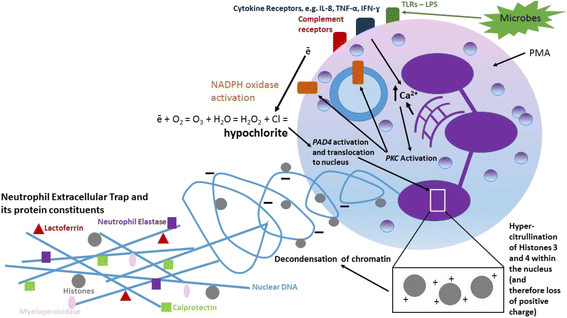Neutrophil extracellular traps and the dysfunctional innate immune response of cystic fibrosis lung disease: a review
- PMID: 29299029
- PMCID: PMC5745605
- DOI: 10.1186/s12950-017-0176-1
Neutrophil extracellular traps and the dysfunctional innate immune response of cystic fibrosis lung disease: a review
Abstract
Background: Cystic Fibrosis (CF) is a devastating genetic disease characterised primarily by unrelenting lung inflammation and infection resulting in premature death and significant morbidity. Neutrophil Extracellular Traps (NETs) are possibly key to inflammation in the disease. This review aims to draw together existing research investigating NETs in the context of a dysfunctional innate immune system in CF.
Main body: NETs have a limited anti-microbial role in CF and studies have shown they are present in higher numbers in CF airways and their protein constituents correlate with lung function decline. Innate immune system cells express CFTR and myeloid-specific CFTR KO mice have greater neutrophil recruitment and higher pro-inflammatory cytokine production to both sterile and bacterial inflammatory challenges. CFTR KO neutrophils have impaired anti-microbial capacity and intrinsic abnormalities in the pH of their cytoplasm, abnormal protein trafficking, increased neutrophil elastase and myeloperoxidase function, and decreased hypochlorite concentrations in their phagolysosomes. Furthermore, neutrophils from CF patients have less intrinsic apoptosis and may be therefore more likely to make NETs. CFTR KO macrophages have high intraphagolysosomal pH and increased toll-like receptor 4 on their cell surface membranes, which inhibit their anti-microbial capacity and render them hyper-responsive to inflammatory stimuli, respectively. Pharmacological treatments for CF target these intrinsic abnormalities of immune dysfunction. Emerging evidence suggests that the absence of CFTR from neutrophils affects NETosis and the interaction of NETs with macrophages.
Conclusion: Current evidence suggests that NETs contribute to inflammation and lung destruction rather than working effectively in their anti-microbial capacity. Further studies focussing on the pro-inflammatory nature of NET constituents are required to identify the exact mechanistic role of NETs in CF and potential therapeutic interventions.
Keywords: Cystic fibrosis; DNase; Inflammation; Macrophages; NETs; Neutrophil extracellular traps; Neutrophils.
Conflict of interest statement
SML is undertaking a Wellcome Trust Clinical Research Training Fellowship (Grant number: 201246/Z/16/Z). RDG is a NHS Research Scotland (NRS) Senior Clinical Fellow. Not applicable. Not applicable.The authors declare that they have no competing interests.Springer Nature remains neutral with regard to jurisdictional claims in published maps and institutional affiliations.
Figures



References
-
- UK CF Registry Annual Data Report 2015. Cystic Fibrosis Trust; 2015 [cited 2016 Aug 24]. Available from: file:///C:/Users/Sheonagh/Downloads/2015%20Registry%20at%20a%20glance%20report.pdf
-
- Dwyer M, Shan Q, D’Ortona S, Maurer R, Mitchell R, Olesen H, et al. Cystic fibrosis sputum DNA has NETosis characteristics and Neutrophil extracellular trap release is regulated by macrophage migration-inhibitory factor. J Innate Immun. 2014;6(6):765–779. doi: 10.1159/000363242. - DOI - PMC - PubMed
Publication types
Grants and funding
LinkOut - more resources
Full Text Sources
Other Literature Sources
Molecular Biology Databases
Research Materials

